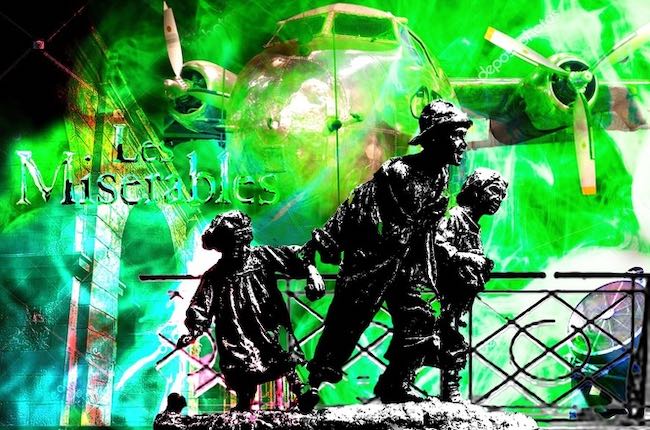In alcuni casi frammentare e poi ricostruire sotto una veste diversa costituisce un modo per andare a osservare le cose da un punto di vista dissimile e innovativo, attraverso il quale mettere in evidenza dettagli e particolari che diversamente sfuggirebbero; alcuni artisti hanno bisogno di misurarsi con questo approccio per compiere di fatto un percorso di analisi della realtà circostante e degli eventi che si susseguono e che lasciano un segno, o semplicemente un ricordo, nell’immaginario comune. Ed è proprio in virtù di questo punto di osservazione differente che è possibile estrarre da avvenimenti, o personaggi, del passato quell’essenza identificativa che emerge così in maniera preponderante rispetto a un percorso più ampio. Nella serie della Digital Art, Ray Piscopo percorre questo cammino di approfondimento e di osservazione, infondendo alle sue opere un aspetto scomposto e di sovrapposizione che tanto aveva contraddistinto un innovativo stile degli anni Sessanta del secolo scorso.
Oltrepassata la prima metà del Novecento, in cui tutte le tecniche e gli stili sembravano tendere verso una ribellione e dunque quasi una distruzione nei confronti di tutte le regole pittoriche e formali precedenti, gli artisti cominciarono ad avvertire la necessità di ricostruire l’arte attingendo alle esperienze dei loro predecessori ma recuperando una vicinanza visiva che tendesse verso il pubblico piuttosto che rimanere legata ai salotti intellettuali, gli unici in grado di comprendere le motivazioni e le radici dei movimenti informali di distacco dall’osservato. Sia la Pop Art che la Street Art, sia il Nouveau Réalisme che l’Iperrealismo, tutti in modi diversi volevano recuperare il contatto con il grande pubblico, quello che di fatto cominciava a dettare le regole del consumismo e anche della fruizione dell’arte; dunque parlare un linguaggio immediatamente comprensibile sembrò diventare l’imperativo di quel periodo tra gli anni Sessanta e i Settanta del Ventesimo secolo e che ebbe varie sfaccettature sulla base delle scelte espressive degli appartenenti a questi movimenti. Malgrado la Pop Art e il Nouveau Réalisme siano considerati contigui, di fatto presentavano profonde differenze poiché laddove negli Stati Uniti la prima utilizzava simboli cinematografici, del mondo dei fumetti, o dei simboli consumistici del popolo americano, introducendo sia la stampa serigrafica che la riproduzione in serie limitate, il Nouveau Réalisme europeo ebbe un approccio più sperimentale, mescolò l’introduzione di materiali all’interno delle opere fin quasi a trasformarle in sculture, sottolineando che qualsiasi oggetto potesse comporre un’opera d’arte, soffermandosi ancora una volta sulla sua unicità e dunque rinunciando alla serialità. Niki de Saint Phalle ideò e costruì addirittura un’intero parco, il Giardino dei Tarocchi, utilizzando frammenti di vetro e di ceramica per decorare completamente le sue interpretazioni giganti delle divinatorie carte; il tema della composizione faceva parte anche della filosofia espressiva degli affichiste, di cui l’Italia ebbe il maggior interprete, Mimmo Rotella, i quali attraverso la tecnica del collage di pezzi di manifesti strappati e poi ricostruiti sotto forma di opera d’arte, costituirono la maggiore rappresentazione del senso della ricostituzione della realtà osservata, e della sua ricomposizione emozionale che va a stimolare la mente dell’osservatore. Di contro, sempre nello stesso periodo, vide la nascita anche un nuovo mezzo artistico, destinato a dare un accesso più democratico alla possibilità di fare arte pur non avendo manualità bensì solo intuizione creativa; parlo ovviamente della Computer Art, che grazie all’intuizione di due non artisti, Manfred Frank, filosofo, e Ben Laposky, matematico, aprì la strada a quella che attualmente prende il nome di Digital Art.
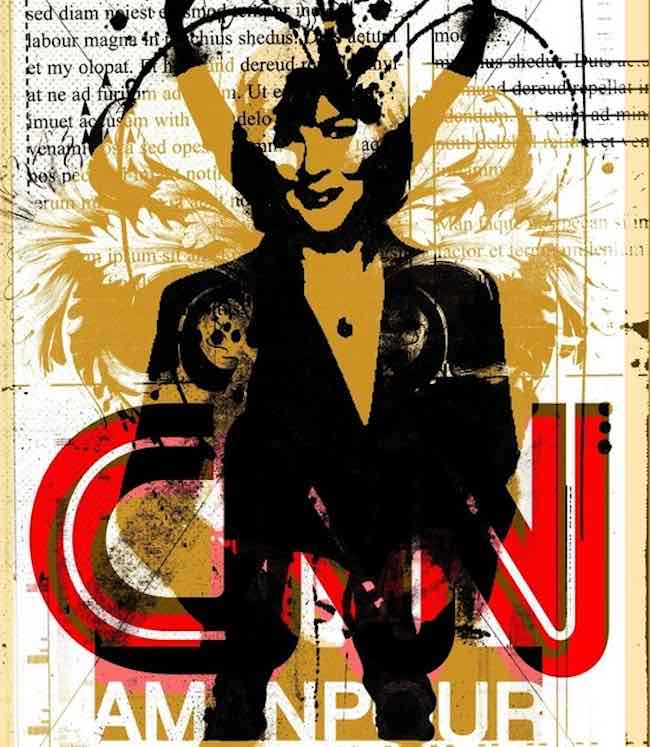
Nella serie che stiamo per andare ad analizzare, Ray Piscopo unisce magistralmente queste due tendenze artistiche, la ricomposizione del Noveau Réalisme e l’utilizzo della Digital Art, che nel suo caso diviene solo un ulteriore mezzo di sperimentazione e non certo l’unico, per compiere un percorso a ritroso nel passato più recente grazie al quale può mettere in evidenza personaggi storici che lo hanno colpito particolarmente, frasi rimaste nella memoria collettiva, celebrazione di momenti salienti nella storia dell’umanità, della musica, del cinema, protagonisti a volte inconsapevoli di circostanze, di parole, destinate a lasciare una traccia indelebile.
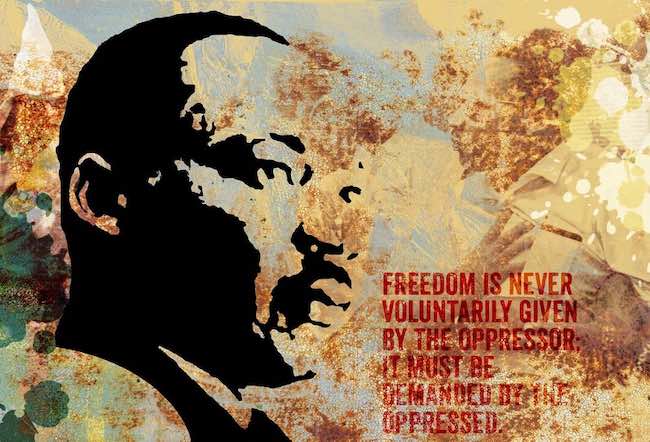
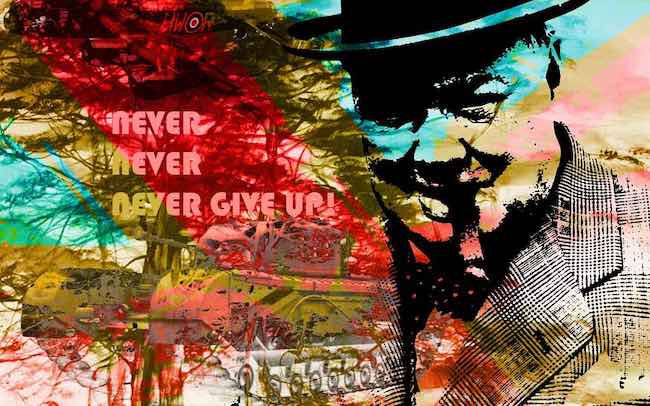
Ray Piscopo scompone i dettagli che appartengono al personaggio o all’evento che di volta in volta vuole mettere in evidenza, ne prende i simboli più forti ed emblematici e poi li ricompone attraverso una Digital Art che si rifà indiscutibilmente alla tecnica del collage del Nouveau Réalisme e che fornisce spunti di riflessione nuovi grazie ai quali l’osservatore è chiamato a riflettere sul senso profondo delle immagini scelte e assemblate dall’artista. L’aspetto finale richiama quello delle locandine tradizionali che prendono come riferimento quelle Art Nouveau modernizzate e adattate ai tempi presenti, mentre la gamma cromatica si armonizza alla circostanza, o al protagonista, in evidenza seppure la prevalenza va dai toni dei gialli ocra, agli arancioni, come a sottolineare quel richiamo al passato, tipico delle fotografie in color seppia, che colloca le circostanze narrate in un arco temporale lontano eppure ancora incredibilmente vicino.
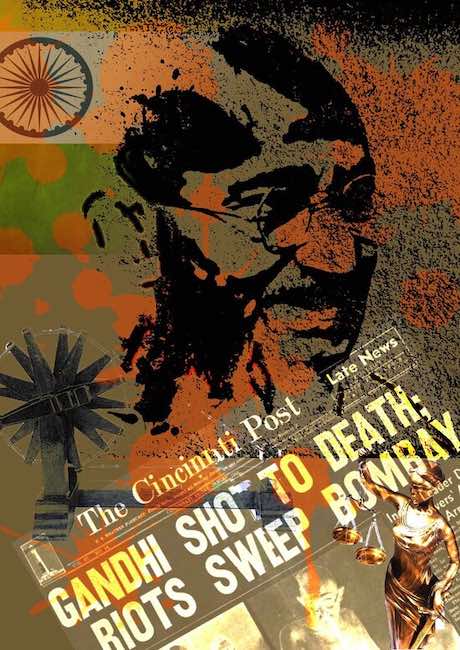
Nell’opera Gandhi, Ray Piscopo rende omaggio a un gigante della lotta per i diritti civili che ha portato all’indipendenza dell’India, ritraendo da un lato la sua grandezza e il suo spessore umano attraverso una delle sue espressioni più conosciute, dall’altro però ricordando il momento più triste per l’umanità intera, quello del suo assassinio; la riflessione dell’artista in merito a quel tragico momento sembra essere di sdegno per la cecità ideologica a causa della quale un fanatico abbia messo fine alla vita di uno dei simboli del Novecento ma al contempo anche la presa d’atto che il percorso compiuto, i risultati conseguiti in un periodo complesso del suo paese e il coraggio con cui ha affrontato tutte le sfide portando con sé milioni di seguaci che ne riconoscevano il messaggio di pace, lo avevano già reso immortale.
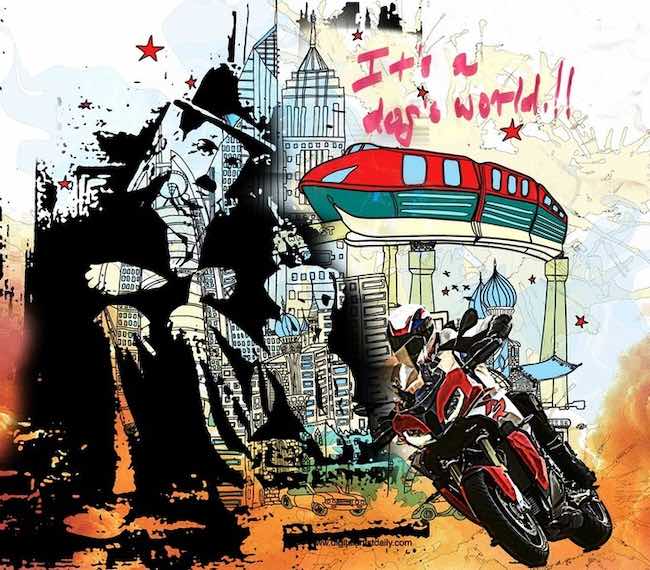
In It’s a dog’s life invece Ray Piscopo rende protagonista un attore, Charlie Chaplin, che con la costruzione del personaggio di Charlot ha saputo interpretare in modo poetico la realtà che si stava sviluppando in quei tempi, tra condizioni di estrema povertà della maggior parte della popolazione e venti di guerra che rendevano la sopravvivenza ogni giorno più difficile. Charlot, il vagabondo pasticcione, voleva mantenere un aspetto e dei modi eleganti, anche quando ricorreva a piccoli furti per procurarsi il cibo e nella narrazione di Piscopo viene contrapposto al lusso e alla ricchezza che invece fa parte della vita contemporanea; l’opera riproduce e porta il titolo di uno dei suoi film più celebri, Vita da cani, immortalandone uno dei fotogrammi più iconici, quello cioè in cui Charlot è seduto con sguardo malinconico con accanto il suo cagnolino, compagno di avventure. Il parallelismo tra il passato e il presente è evidente e tende a sottolineare quanto fossero più profondi i valori quando non si aveva nulla piuttosto che nell’attualità dove l’apparire diviene prioritario sull’essere; Ray Piscopo sembra dunque domandarsi quanto il progresso e il miglioramento delle condizioni di vita siano stati un miglioramento per l’umanità, e lo fa attraverso la sovrapposizione tra la semplicità di un personaggio come Charlot e il lusso di una moto di grande cilindrata e di un treno ad alta velocità.
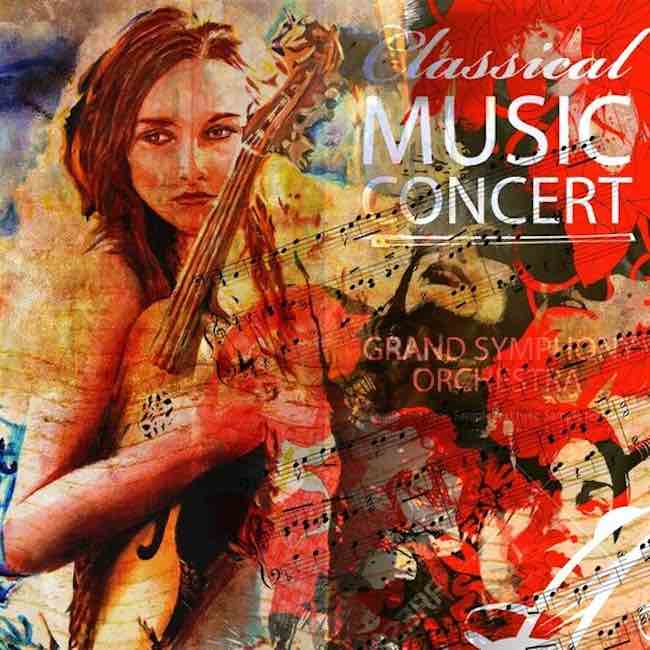
Nell’opera Girl in concert al contrario, ciò che emerge è la magia che la musica diffonde, a prescindere che a eseguirla sia qualcuno di conosciuto perché ciò che conta davvero è la melodia che fuoriesce da uno strumento, che sia una chitarra, un violino o un pianoforte non importa; l’attenzione di Ray Piscopo è concentrata infatti sul fascino che da sempre le note musicali esercitano sull’uomo, avvolgendo la quotidianità della possibilità di evadere, anche se solo per pochi minuti, e di entrare in una dimensione in cui l’interiorità è chiamata a essere protagonista, a liberarsi dalla gabbia della razionalità e a lasciarsi andare alla pura bellezza. La locandina immaginata da Piscopo diviene dunque manifestazione di quella poetica leggerezza, dell’armonia che si manifesta attraverso il rigo musicale e che si ripercuote poi al titolo generico di un concerto e infine all’aspetto rapito della protagonista dell’opera.
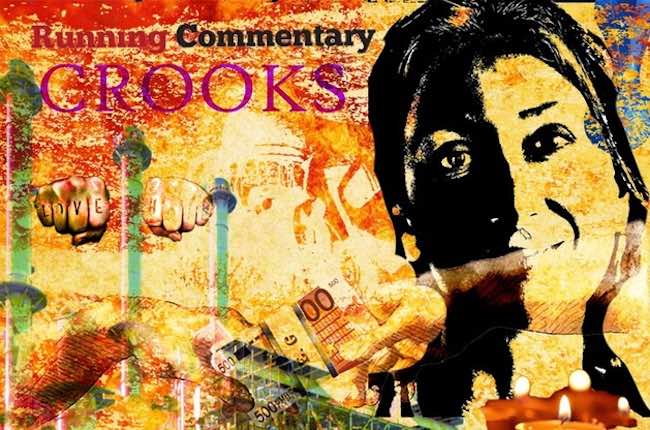
Dunque il Nouveau Réalisme è una delle tante sfaccettature creative del poliedrico Ray Piscopo, che sa misurarsi con diversi mezzi e sperimentare molteplici linguaggi espressivi.
Marta Lock
RAY PISCOPO-CONTATTI
Email: piscopoart@gmail.com
Sito web: www.piscopoart.com/
Facebook: www.facebook.com/ray.piscopo
Instagram: www.instagram.com/raypiscopo/
Ray Piscopo’s compositions in Nouveau Réalisme style, between characters from modern history and imaginary posters of salient events
In some cases, fragmenting and then reconstructing under a different guise constitutes a way of observing things from a dissimilar and innovative point of view, through which putting in evidence details and particulars that would otherwise escape; some artists need to measure themselves with this approach in order to actually carry out a path of analysis of the surrounding reality and of the events that follow one another and that leave a mark, or simply a memory, in the common imagination. And it is precisely by virtue of this different point of observation that it is possible to extract from events, or characters, of the past that identifying essence that thus emerges in a preponderant manner with respect to a broader path. In the Digital Art series, Ray Piscopo travels this path of in-depth analysis and observation, infusing his artworks with a decomposed and overlapping aspect that was so characteristic of an innovative style in the 1960s.
Beyond the first half of the 20th century, in which all techniques and styles seemed to tend towards a rebellion and thus almost a destruction of all previous pictorial and formal rules, artists began to feel the need to reconstruct art by drawing on the experiences of their predecessors but recovering a visual proximity that tended towards the public rather than remaining tied to the intellectual salons, the only ones capable of understanding the motivations and roots of the informal movements of detachment from the observed. Both Pop Art and Street Art, Nouveau Réalisme and Hyperrealism, all in different ways wanted to regain contact with the great public, the one that was in fact beginning to dictate the rules of consumerism and also of the enjoyment of art; therefore speaking an immediately comprehensible language seemed to become the imperative of that period between the 1960s and 1970s and that had various facets on the basis of the expressive choices of the members of these movements. Although Pop Art and Nouveau Réalisme are considered to be contiguous, they in fact had profound differences, for whereas in the United States the former used symbols from the cinema, the world of comics, or the consumerist symbols of the American people, introducing both silk-screen printing and reproduction in limited series, the European Nouveau Réalisme had a more experimental approach, mixing the introduction of materials into the works almost to the point of turning them into sculptures, emphasising that any object could make up a work of art, again emphasising its uniqueness and thus renouncing seriality.
Niki de Saint Phalle even designed and built an entire park, the Tarot Garden, using fragments of glass and ceramics to completely decorate her giant interpretations of the divinatory cards; the theme of composition was also part of the expressive philosophy of the Affichistas, of which Italy had the greatest interpreter, Mimmo Rotella, who through the technique of collage of torn pieces of posters and then reconstructed in the form of a work of art, constituted the greatest representation of the sense of the reconstitution of observed reality, and its emotional recomposition that stimulates the mind of the observer. On the other hand, the same period also saw the birth of a new artistic medium, destined to give more democratic access to the possibility of making art despite not having manual skills but only creative intuition; I am of course talking about Computer Art, which thanks to the intuition of two non-artists, Manfred Frank, a philosopher, and Ben Laposky, a mathematician, paved the way for what is currently known as Digital Art. In the series we are about to analyse, Ray Piscopo masterfully combines these two artistic trends, the recomposition of Noveau Réalisme and the use of Digital Art, which in his case becomes just one more means of experimentation and certainly not the only one, to take a journey back into the most recent past thanks to which he can highlight historical figures that have particularly impressed him, phrases that have remained in the collective memory, celebrations of salient moments in the history of mankind, of music, of cinema, sometimes unaware protagonists of circumstances, of words, destined to leave an indelible mark.
Ray Piscopo breaks down the details that belong to the character or event he wishes to highlight, takes its strongest and most emblematic symbols and then recomposes them through a Digital Art that unquestionably refers to the collage technique of Nouveau Réalisme and that provides new food for thought thanks to which the observer is called upon to reflect on the profound meaning of the images chosen and assembled by the artist. The final look is reminiscent of traditional posters that take Art Nouveau ones as a reference, modernised and adapted to present times, while the colour palette harmonises with the circumstance, or the protagonist, in evidence, although the prevalence ranges from shades of yellow ochres to oranges, as if to emphasise that call to the past, typical of sepia-toned photographs, which places the narrated circumstances in a distant yet still incredibly close time span. In the artwork Gandhi, Ray Piscopo pays tribute to a giant of the struggle for civil rights that led to India’s independence, on the one hand portraying his greatness and human depth through one of his best-known expressions, but on the other hand recalling the saddest moment for all humanity, that of his assassination; the artist’s reflection on that tragic moment seems to be one of indignation at the ideological blindness through which a fanatic put an end to the life of one of the symbols of the 20th century, but at the same time also the realisation that the path he had travelled, the results he had achieved in a complex period of his country and the courage with which he faced all the challenges, bringing with him millions of followers who recognised his message of peace, had already made him immortal. In It’s a dog’s life, on the other hand, Ray Piscopo makes protagonist an actor, Charlie Chaplin, who with the construction of the character of the Tramp, was able to poetically interpret the reality that was developing at the time, amidst conditions of extreme poverty of the majority of the population and winds of war that made survival more difficult every day.
The Tramp, the bungling vagabond, wanted to maintain an elegant appearance and manners, even when he resorted to petty theft to procure food, and in Piscopo‘s narrative he is contrasted with the luxury and wealth that is part of contemporary life; the artwork reproduces and bears the title of one of his most famous films, Life as a Dog, immortalising one of its most iconic frames, the one in which the Tramp sits with a melancholic look with his little dog, his companion in adventures, beside him. The parallelism between the past and the present is evident and tends to emphasise how much deeper the values were when one had nothing rather than in the present where appearances take priority over being; Ray Piscopo thus seems to wonder how much progress and improved living conditions have been an evolution for mankind, and he does so through the overlap between the simplicity of a character like the Tramp and the luxury of a big motorbike and a high-speed train.
In the artwork Girl in Concert, on the contrary, what emerges is the magic that music spreads, regardless of whether it is performed by someone known, because what really counts is the melody that comes out of an instrument, whether it is a guitar, a violin or a piano does not matter; in fact, Ray Piscopo‘s attention is focused on the fascination that musical notes have always exerted on man, enveloping everyday life with the possibility of escaping, even if only for a few minutes, and entering a dimension in which interiority is called upon to be the protagonist, to free itself from the cage of rationality and let itself go to pure beauty. The playbill imagined by Piscopo thus becomes a manifestation of that poetic lightness, of the harmony that manifests itself through the musical line and is then reflected in the generic title of a concert and finally in the rapt look of the work’s protagonist. So Nouveau Réalisme is one of the many creative facets of the multifaceted Ray Piscopo, who is able to measure himself with different media and experiment with multiple expressive languages.


